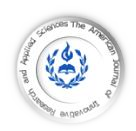
GENERAL INFORMATION
| HOME | ABOUT US | ARCHIVE | AIMS AND SCOP | AUTHORS | REVIEW | SUMIBMIT MANUSCRIPT | EDITORIAL BOARED | PUBLICATION FEE |

| HOME || ABOUT US || ARCHIVES || AIMS AND SCOP || AUTHORS || REVIEW|| SUBMIT MANUSCRIPT || EDITORIAL BOARD |

| Info-AJIRAS-® Journal ISSN 2429-5396 (Online) / Reference CIF/15/0289M |
American Journal of Innovative Research & Applied Sciences

|
American Journal of innovative
Research & Applied Sciences
Research & Applied Sciences
ISSN 2429-5396 (Online)
OCLC Number: 920041286
OCLC Number: 920041286

Authors Contact
*Correspondant author and authors Copyright © 2022:
| Irenge Mitima Honoré *| Byumanine Ntabaza Roger | Bwami Musombwa Gervais| et | Wimba Kayange Louisette |
Affiliation.
Institut Supérieur des Techniques Médicales de Bukavu | Bukavu | République Démocratique du Congo |
This article is made freely available as part of this journal's Open Access: ID | Irenge-Ref7-15-ajiras281122|
*Correspondant author and authors Copyright © 2022:
| Irenge Mitima Honoré *| Byumanine Ntabaza Roger | Bwami Musombwa Gervais| et | Wimba Kayange Louisette |
Affiliation.
Institut Supérieur des Techniques Médicales de Bukavu | Bukavu | République Démocratique du Congo |
This article is made freely available as part of this journal's Open Access: ID | Irenge-Ref7-15-ajiras281122|



RESUME
Objectif : La présente étude a pour objectif d’évaluer le degré d’assimilation du cours de chimie analytique par des travaux pratiques au laboratoire. Méthodes : Il s'agit d'une étude qualitative établie sur la distribution des notes obtenues : excellente ; forte ; moyenne et faible et quantitative car, basée sur le taux d'assimilation de la matière. La démarche a consisté à : jauger le niveau initial d’assimilation du cours par des travaux dirigés et, des interrogations orales. Pour cela, la documentation nécessaire a été réunie, des groupes de travail ont été constitués à chaque séance du jour, en moyenne 13 étudiants par groupe avec une cotation individuelle et non par groupe, les protocoles des manipulations ont été mis à la disposition des apprenants avant d’accéder au laboratoire, lesquels étaient répétés, une fois dans la salle des manipulations. La méthode participative et pédagogique qui consistait à faire travailler chaque étudiant et ne devenir que leurs accompagnateurs et facilitateurs de l’activité d’enseignement-apprentissage. Les analyses statistiques sont réalisées par le logiciel IBM SPSS Statistics 20. Résultats : Les résultats obtenus ont montré que 80,753% du taux a été atteint dans l’ensemble dont 88,034% en G2 techniques pharmaceutiques (G2TPH), 73,770% en G2 techniques des laboratoires (G2TL). Cette étude étant à la fois qualitative et quantitative, nous a permis de scinder les effectifs en quatre classes selon les notes obtenues. Conclusion : L’étude a montré que les étudiants ont très bien assimilé le cours de chimie analytique après les travaux pratiques au laboratoire. Les étudiants de G2 techniques pharmaceutiques ont très bien assimilé par rapport à ceux de G2 techniques de laboratoires.
Mots clés : Chimie analytique, degré d’assimilation, G2 techniques pharmaceutiques et laboratoires, notes obtenues.
ABSTRACT
Objective: The objective of this study is to evaluate the degree of assimilation of the course of analytical chemistry by practical work in the laboratory. Methods: It is a qualitative study established on the division into classes on the basis of the marks obtained: excellent; strong; average and weak and quantitative because, based on the rate of assimilation of the matter. The approach consisted in : gauging the initial level of assimilation of the course through tutorials and oral questioning. For that, the necessary documentation was gathered, work groups were constituted at each session of the day, on average 13 students per group with an individual quotation and not by group, the protocols of the manipulations were placed at the disposal of the learners before reaching the laboratory, which were repeated, once in the room of the manipulations. The participatory and pedagogical method consisted in making each student work and become only their guides and facilitators of the teaching-learning activity. The statistical analyses were carried out using the IBM SPSS Statistics 20 software. Results: The results obtained showed that 80.753% of the rate was achieved overall including 88.034% in G2 pharmaceutical techniques (G2TPH), 73.770% in G2 laboratory techniques (G2TL). This study being both qualitative and quantitative, allowed us to divide the workforce into four classes according to the grades obtained. Conclusion: The study showed that the students assimilated the analytical chemistry course very well after the practical work in the laboratory. The students of G2 pharmaceutical techniques assimilated very well compared to those of G2 laboratory techniques.
Key words: Analytical chemistry, degree of assimilation, G2 pharmaceutical technics and laboratories, obtained grades.
Objectif : La présente étude a pour objectif d’évaluer le degré d’assimilation du cours de chimie analytique par des travaux pratiques au laboratoire. Méthodes : Il s'agit d'une étude qualitative établie sur la distribution des notes obtenues : excellente ; forte ; moyenne et faible et quantitative car, basée sur le taux d'assimilation de la matière. La démarche a consisté à : jauger le niveau initial d’assimilation du cours par des travaux dirigés et, des interrogations orales. Pour cela, la documentation nécessaire a été réunie, des groupes de travail ont été constitués à chaque séance du jour, en moyenne 13 étudiants par groupe avec une cotation individuelle et non par groupe, les protocoles des manipulations ont été mis à la disposition des apprenants avant d’accéder au laboratoire, lesquels étaient répétés, une fois dans la salle des manipulations. La méthode participative et pédagogique qui consistait à faire travailler chaque étudiant et ne devenir que leurs accompagnateurs et facilitateurs de l’activité d’enseignement-apprentissage. Les analyses statistiques sont réalisées par le logiciel IBM SPSS Statistics 20. Résultats : Les résultats obtenus ont montré que 80,753% du taux a été atteint dans l’ensemble dont 88,034% en G2 techniques pharmaceutiques (G2TPH), 73,770% en G2 techniques des laboratoires (G2TL). Cette étude étant à la fois qualitative et quantitative, nous a permis de scinder les effectifs en quatre classes selon les notes obtenues. Conclusion : L’étude a montré que les étudiants ont très bien assimilé le cours de chimie analytique après les travaux pratiques au laboratoire. Les étudiants de G2 techniques pharmaceutiques ont très bien assimilé par rapport à ceux de G2 techniques de laboratoires.
Mots clés : Chimie analytique, degré d’assimilation, G2 techniques pharmaceutiques et laboratoires, notes obtenues.
ABSTRACT
Objective: The objective of this study is to evaluate the degree of assimilation of the course of analytical chemistry by practical work in the laboratory. Methods: It is a qualitative study established on the division into classes on the basis of the marks obtained: excellent; strong; average and weak and quantitative because, based on the rate of assimilation of the matter. The approach consisted in : gauging the initial level of assimilation of the course through tutorials and oral questioning. For that, the necessary documentation was gathered, work groups were constituted at each session of the day, on average 13 students per group with an individual quotation and not by group, the protocols of the manipulations were placed at the disposal of the learners before reaching the laboratory, which were repeated, once in the room of the manipulations. The participatory and pedagogical method consisted in making each student work and become only their guides and facilitators of the teaching-learning activity. The statistical analyses were carried out using the IBM SPSS Statistics 20 software. Results: The results obtained showed that 80.753% of the rate was achieved overall including 88.034% in G2 pharmaceutical techniques (G2TPH), 73.770% in G2 laboratory techniques (G2TL). This study being both qualitative and quantitative, allowed us to divide the workforce into four classes according to the grades obtained. Conclusion: The study showed that the students assimilated the analytical chemistry course very well after the practical work in the laboratory. The students of G2 pharmaceutical techniques assimilated very well compared to those of G2 laboratory techniques.
Key words: Analytical chemistry, degree of assimilation, G2 pharmaceutical technics and laboratories, obtained grades.

| ISSN: 2429-5396 (e) | https://www.american-jiras.com | |
| Web Site Form: v 0.1.05 | JF 22 Cours, Wellington le Clairval, Lillebonne | France |
| Web Site Form: v 0.1.05 | JF 22 Cours, Wellington le Clairval, Lillebonne | France |
| DECEMBER | VOLUME 15 | ISSUE N° 6 | 2022 |
| ARTICLES | Am. J. innov. res. appl. sci. Volume 15, Issue - 6 Pages 213-225 (Decmber 2022)
EVALUATION DU DEGRE D’ASSIMILATION DU COURS DE CHIMIE ANALYTIQUE APRES LES TRAVAUX PRATIQUES
EVALUATION OF THE DEGREE OF ASSIMILATION OF THE ANALYTICAL CHEMISTRY COURSE AFTER THE PRACTICAL WORK
| Irenge Mitima Honoré *| Byumanine Ntabaza Roger | Bwami Musombwa Gervais| et | Wimba Kayange Louisette |. Am. J. innov. res. appl. sci. 2022; 15(6):213-224.
| PDF FULL TEXT | | XML FILE|
EVALUATION OF THE DEGREE OF ASSIMILATION OF THE ANALYTICAL CHEMISTRY COURSE AFTER THE PRACTICAL WORK
| Irenge Mitima Honoré *| Byumanine Ntabaza Roger | Bwami Musombwa Gervais| et | Wimba Kayange Louisette |. Am. J. innov. res. appl. sci. 2022; 15(6):213-224.
| PDF FULL TEXT | | XML FILE|